Maud Nelissen
The Journal of Filmpreservation of the FIAFF ( Federation of International Archives)
Issue 04/2016
Some years ago I was asked by the former Dutch Film Museum (renamed Eye Film Institute today) to accompany The Merry Widow, directed by Erich von Stroheim. I was familiar with the operetta and its composer Franz Lehar so I was expecting something similar. With a slight feeling of an easy task ahead I was totally blown away after the first viewing. I realised that my one piano – one singer accompaniment wasn’t nearly enough to do justice, musically,to this great work of art. Ahead of me lay a long but interesting path. This article describes not only the development of a musical score over several years to what it has become now, in 2016, but also my vision of The Merry Widow and the steps I took to reach as close as possible, musically speaking, to this wonderful film and its director.

Maud Nelissen talking about composing music for silent films at a conference in Zeist (Netherlands), with an image of Mae Murray from “The Merry Widow” in the background. (Photo: Maud Nelissen)
The Merry Widow is a slightly undervalued film in von Stroheim’s oeuvre not least because Stroheim himself spread the word that he didn’t like the film:
“I abandoned all my ideals to create real art pictures and made pictures to order from now on. My film The Merry Widow proved that this kind of picture is liked by the public. but I’m far from being proud of it and I do not want to be identified with so called box-office attractions. So I have quit realism entirely….When you ask me why I do such pictures I am not ashamed to tell you the true reason : only because I do not want my family to starve” [i]
Von Stroheim’s feelings were not shared by audiences since The Merry Widow was one of the biggest box-office successes of 1925. Even Franz Lehar was impressed by the film. He said that if he hadn’t already composed the music he would have been inspired by Erich von Stroheim’s version.[ii]

Poster for the 1925 Hollywood version of “Merry Widow.”
Von Stroheim’s reluctance to start shooting is understandable, after the demolition of his great work of passion, Greed, although anyone who sees this Merry Widow, filmed directly after Greed, will realise that it must have been made by a director who was still inspired, and who had given the operetta a brilliant personal twist. After The Merry Widow, Stroheim returned to the theme of the decline of the aristocracy, so it must have intrigued him more than he cared to admit.
Die Lustige Witwe of Lehar was premiered in 1905 in the Theater an der Wien in Vienna and became an immensely successful operetta. Stroheim claimed to have seen it in this year at this theatre. [iii]
The story concerns a very rich widow, Hanna Glawari, and the attempts of her fellow countrymen to keep her money in the country by finding her the right husband. At the end she marries her former lover, Danilo, who gives up his wildly cherished bachelorhood for her.
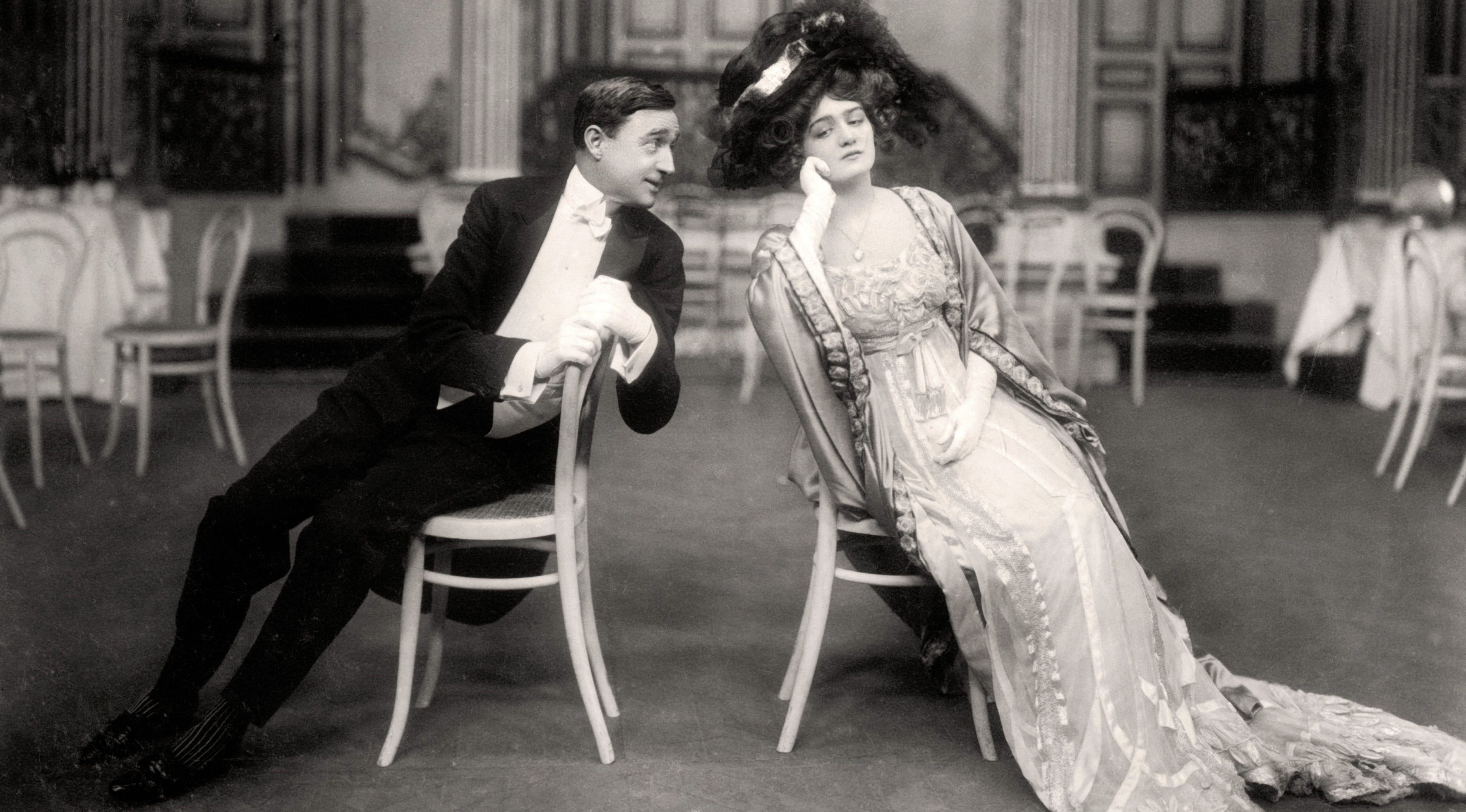
Lily Elsie and Joseph Coyne in ‘The Merry Widow’, London 1907. (Photo: Archive Operetta Research Center)
The libretto of Léon & Stein was based upon a comedy L’Attaché d’ambassade of Henry Meilhac and is set in Paris around 1900. Stroheim realised that despite Lehar’s captivating music, the story itself was too thin to make an interesting film and together with Benjamin Glazer he was permitted by Irving Thalberg to rewrite the libretto. Stroheim moulded the story to his own artistic beliefs, accepting Thalberg’s only condition that hekeep the two most popular operetta moments: the nightclub scene at Maxim’s and The Merry Widow Waltz danced at Hanna’s grand entrance in Paris. [iv]
What came out of this was a film script almost completely different from the operetta.
Hanna, coming from a noble Marsovian (European) background is replaced by Sally O’Hara, a New York Follies girl with a rather questionable background.

Erich von Stroheim going through the piano score of “The Merry Widow” with his star, Mae Murray. She wanted him fired after he had told her that he seens Sally/Hanna as a “whore.”
Stroheim, with his need for a thorough exploration of character, takes 70% of the script to explain how Sally becomes a widow, which, until the final pages, makes any resemblance to the operetta purely coincidental.But the most inventive aspect of the adaptation is the splitting of the Danilo character into two.[v] It delivers the dark, villainous Crown Prince Mirko and the bon vivant Prince Danilo, both coming from Monteblanco, a small principality deep in the Balkans, where almost all the action occurs.
Starting with the same lightheartedness as the original operetta, the film version becomes darker and dramatically more intense. Stroheim takes an analytically sarcastic view of status, money, love and eroticism and slowly and brilliantly reveals their essence.

One of the intimate scenes between Mae Murray and John Gilbert in “The Merry Widow,” 1925.
Challenges for arranger & composer
So there it is; quite a genial film story, in all respects larger then the original operetta, located mostly in wild Balkan surroundings rather than Lehar’s sophisticated Paris. The Lehar Estate still needed to give me permission for the use of the composer’s music, although, as usual, no money for developing or fitting a score. But, who cared! The project was too interesting not to do it and financially it felt appropriate to start it all in a ‘Stroheimian’ way and slowly follow this path, step by step. First of all, I found out about the original score, written for full orchestra in 1925 by Axt and Mendoza (MGM’s house composers) and also based on Lehar. This partiture would have been most interesting to explore, but despite my efforts, it was not traceable. Perhaps it is guarded by a secretive collector?
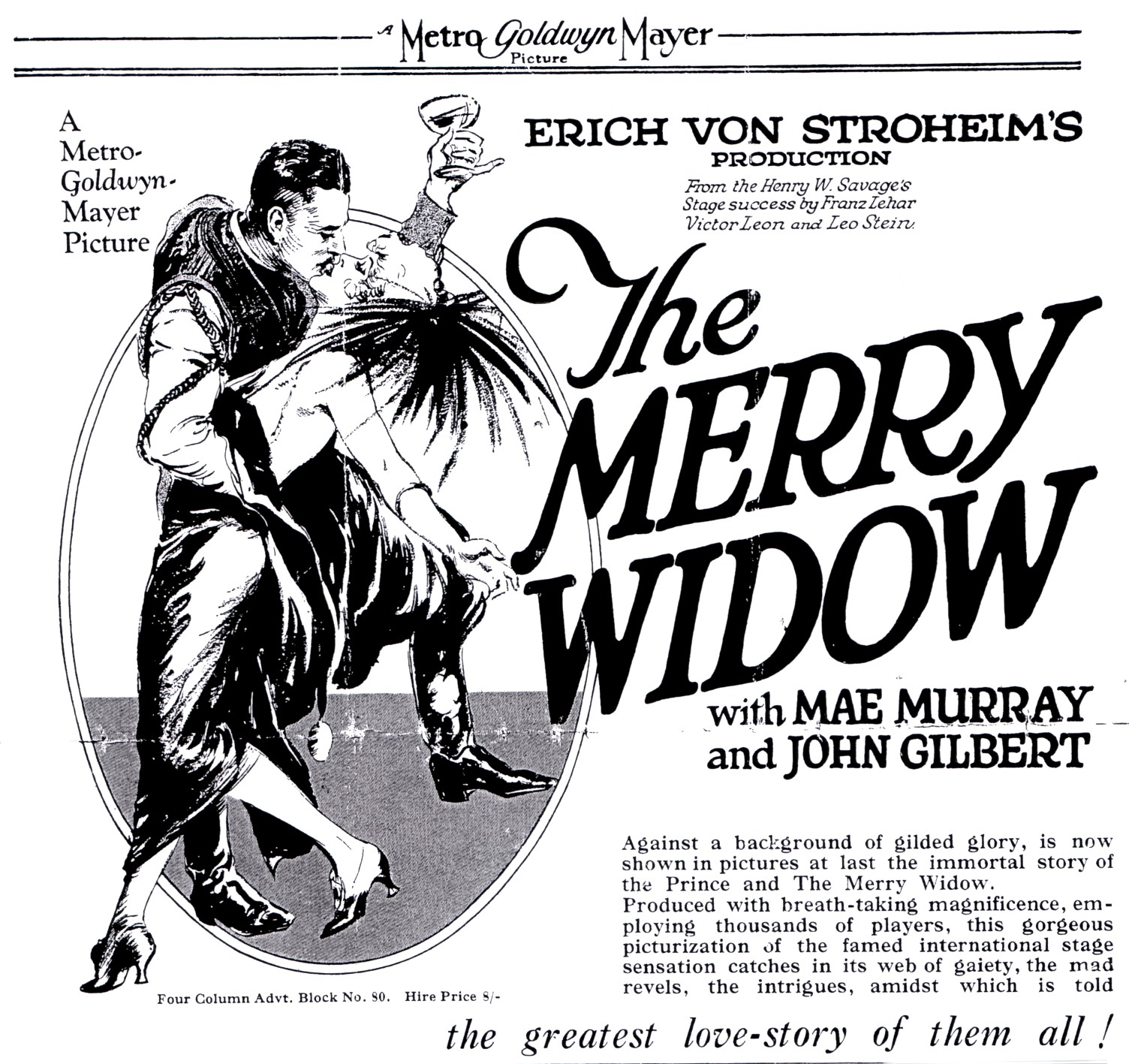
The immensley successful silent movie version from 1925, directed by Erich von Stroheim.
The use of Lehar’s music and the libretto of Leon & Stein
For my second version of the score I decided to abandon the idea of using a singer in the accompaniment. It would distract too much, so for a better musical line-up I took a deeper look at Lehar’s music and the film.
Franz Lehar had an astonishing ability to write unforgettably lyrical melodies which were brilliantly orchestrated. Also his music possesses an appealing sensuality. In terms of grandeur, sweetness, lyricism and eroticism, Stroheim couldn’t have wished for a better musical companion. But still there was musical darkness, melancholy and sarcasm to inject into the Lehar structure to bring us closer to Stroheim’s world. I discovered my first important clue to solving this problem. When you watch the film, the first night Sally and Danilo dance at the picturesque mountain inn, there is an enchanting ‘wild’ Balkan orchestra of 8 musicians playing Lehar melodies. The musical line-up is different from the usual string-dominated Lehar orchestra. The difference here is due to the use of an accordion and some peculiar regional instruments.

Erich von Stroheim with his two stars, Mae Murray and John Gilbert, shotting “The Merry Widow,” 1925. Miss Murray is seen here in her “showgirl” costume.” (Photo: Archive Operetta Research Center)
An accordion is quite versatile. It can sound extremely lyrical, cosy or funny; at the same time, it can haunt youwith sinister clusters of very bright or dark sound. This ability gave me the perfect black icing on the sometimes too sweet Lehar cake.
I decided to follow this Balkan line-up, replacing certain instruments and extending the ensemble to 10 musicians in order to cover the jazz scenesand incorporated an intoxicating Balkan melody.
But the biggest puzzle still had to be solved : how to use an operetta for a film in which 70 % is not about the operetta? The libretto, which must have inspired Von Stroheim, was the solution.
Von Stroheim ‘s hints about the operetta were already quite inventive during the opening scenes. When Danilo arrives in a muddy mountain village [vi] I couldn’t resist singing the song ‘Oh fatherland you cause my day.’ The Parisian nightclub girls’ names – ‘Lolo, Dodo, Joujou, Clocio, Margot, Froufrou’ from the famous Maxim’s song – work extremely well with the “ - nice little pigs and nice little women – “ Danilo encounters in this village and are hilarious when you know the source.

John Gilbert as Prince Danilo with the can-can girls in “The Merry Widow,” 1925. (Photo: Archive Operetta Research Center)
So Stroheim definitely refersto the libretto at the beginning of the film, but he uses it more freely and for totally different scenes than it was originally meant for. Although the first one-and- a-half hours stay musically a wild guess, if you check the duration of certain scenes it is evident that some complete Lehar songs were the source of the director’s inspiration – they fit perfectly!
Finally, it must have been a pleasure for von Stroheim, who was always very involved with the music in his films,[vii] to work with this music and libretto. Lehar, after all, was one of his favourite composers.
“Hab mich lieb ?”
While slowly developing the score for larger orchestral forces, I was very privileged in 2005 to receive from the Lehar Estate final approval for the use and re-arrangement of the music. A score which now could and would exist of 70% re-arranged Lehar and 30% my own composition. At this period, I had started to accompany The Merry Widow with a smaller ensemble and noticed how deeply the film and its music emotionally affected audiences. A memorable thing happened during these film concerts to the spectators which made me realise that von Stroheim’s intentions with The Merry Widow might go far beyond the urge to reveal the true essence of status, money, love and eroticism.
During the first lighter and funnier part of the film, we, the audience, are laughing like voyeurs from the outside at this distant, slightly twisted world we have been presented with. All of a sudden, just before the story takes a dramatic twist, a huge, cruelly beautiful mirror is turned upon us. The scene that makes this happen is the love scene where Sally shows Danilo for the very first time hervulnerability.
Sally : “ – I thought – I hoped – - that you were different – - “
Danilo : “ – is it – because – you don’t care enough? – - please – Sally – answer me – “
Sally : “ – it’s because I care – so much – “
A change takes place within Danilo and it’s exactly the purity of this moment connecting two souls which overwhelms and which is strongly emphasised by the only Lehar song possible here: “Lippen schweigen, ‘s flüstern Geigen, hab mich lieb!” (“Lips fall silent, violins whisper: love me”)
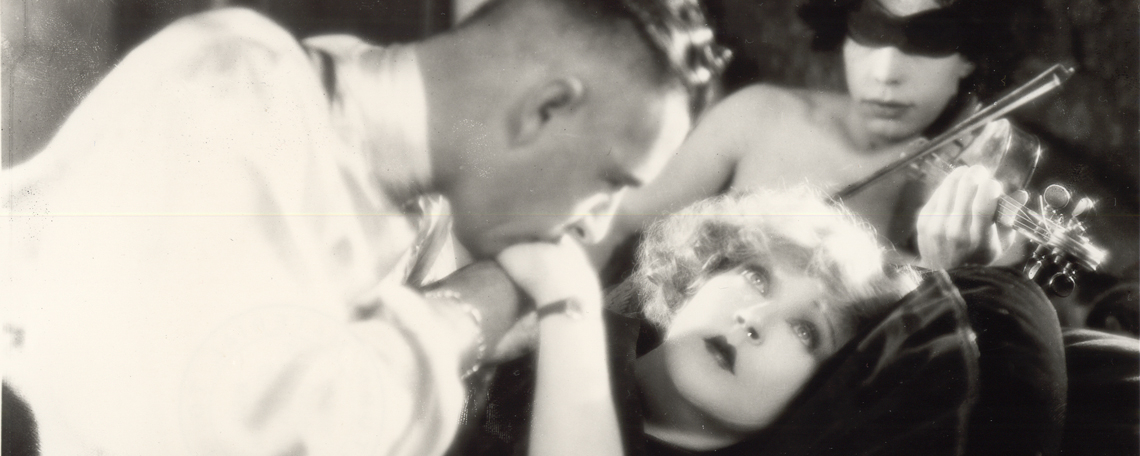
John Gilbert as Danilo, seducing Mae Murray. (Photo: Staatsoperette Dresden)
The correct meaning of “Hab mich lieb” goes much further than love between man and woman and is in my opinion the most essential message von Stroheim tries to give in this scene and perhaps in other films of his. A message often obscured by his strongly pessimistic thoughts on human nature. After this striking scene, the director immediately takes us into the Merry Widow’s darker depths but now it seems we are ready for a more open look into this mirror.
The undercurrent and Vienna
Having discovered more and more about Erich von Stroheim, I’m convinced that most of his qualities as director lie in his frequent recourse to the viewers’ subconscious’.[viii]
This relates to the undercurrent which composers (sometimes) create within their pieces and which can best be sensed in music and film, as opposed to being grasped by the analytical mind.
In The Merry Widow, for instance,I was experiencing with shivers the small crucifixes evolving into gigantic proportions throughout the film.
Erich von Stroheim’s love for the ‘wordless’has been the biggest source of musical inspiration for me. It must have been deeply rooted in his youth in Vienna, a city I am glad to have visited several times. The different colours of this undercurrent world of Vienna, which von Stroheim inhaled so intensely, are wonderfully set at Vienna’s burial places or described in its songs and its poetry.
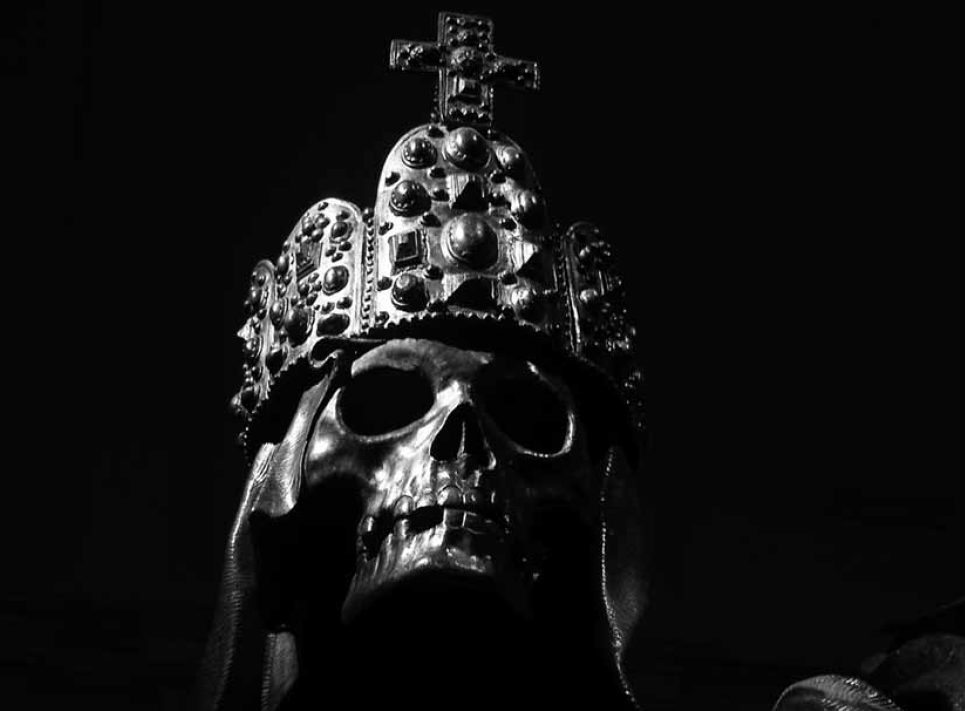
Scene from the Imperial Crypt where several Habsburgs have been buried.
The Imperial Crypt where several Habsburgs have been buried, breathes even more strongly than a Stroheim-created film set. The Viennese people concern themselves with death quite happily during their lifetime: they sing about it,“Der Tod, das muss ein Wiener sein”-“Death must be a Viennese”- .Viennese play with it and build monuments to it. The cult of the dead in Vienna is a slightly macabre yet gleeful manifestation, and a strategically clever move against the limitations of life. [ix]
The Vienna, which the poet Franz Grillparzer describes so beautifully in “Abschied von Wien”,“Goodbye to Vienna”(1847) [x] , delivers another glimpse of Stroheim’s silent inner world,
Goodbye to Vienna
Beautiful art thou; but dangerous too,
To the pupil as the master,
Enervating wafts thy summer breeze
Thou Capua [xi] of minds.
Everywhere music, as if a choir of birds
Had awakened in a tree
One does not speak, he scarcely thinks,
And feels what has been half-thought.
Yet because filled with so much beauty
We merely have to breathe,
One forget’s to exhale
What has poured into the heart.
And finally, when the analytical words still need to be spoken, they are ruthlessly cut down in one of Vienna’s most intriguing rituals: the traditional ceremony of the burial of the Habsburg emperors.[xii]Three timesthe master of ceremonies knocks on the cryptdoors and twice the coffin is denied entry — first when Habsburg is named as emperor and holder of dozens of other regal titles, then when his academic and political achievements are listed.
“We do not know him!” is the response from the Capuchin friars within. The doors open only after the late Emperor is described as “a Mortal and a Sinner.”
Erich von Stroheim must have loved this naked truth the most. - ‘just plain Danilo Petrovich.’ [xiii]
In my music, I have tried to capture these important feelings about Stroheim’s roots in Habsburg Vienna, through specific orchestrations or the change of sound colours during the dynamic build up of long musical lines or, sometimes, the use of near silence.
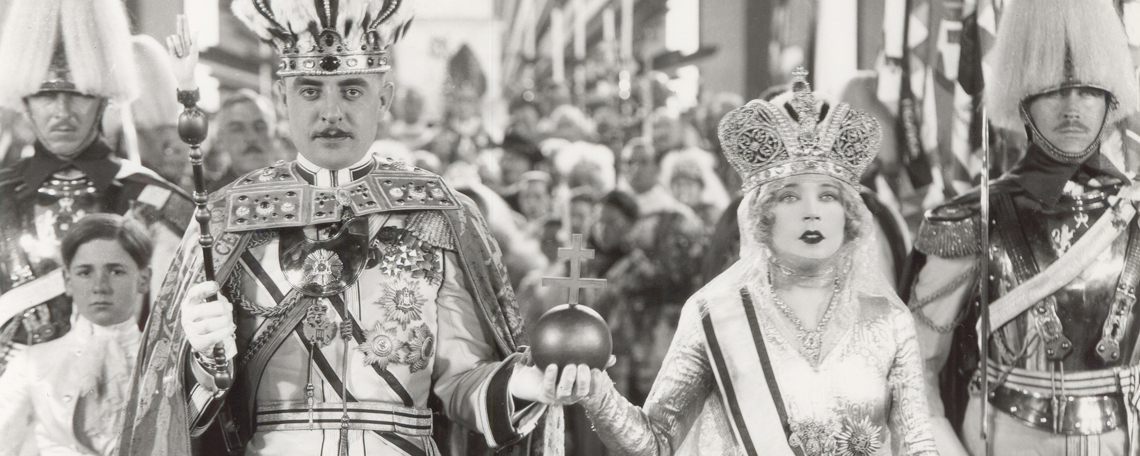
The grand finale from “The Merry Widow” 1925. (Photo: Staatsoperette Dresden)
The Merry Widow in 2016
The presentation of von Stroheim’s Merry Widow in Vienna in 2012 at The Theater an der Wien on Sylvester Night ,with the Vienna Chamber Orchestra, exactly 108 years after the premiere of Lehar’s operetta at the same venue, made the dream of bringing Stroheim’s masterpiece back to Vienna and Viennese audiences come true. It was a night I shall never forget. The Merry Widow with chamber orchestra was also presented in Pordenone in 2009 and in Bologna in 2014. Finally, in 2015, a last challenge: preparing a re-orchestrated and reconsidered version for full symphony orchestra.
Now in 2016, I’m happy to announce there will be two orchestral scores for The Merry Widow; a version for an ensemble of 10 musicians designed for smaller venues and the full orchestral score which will have its premiere in the near future.While there is no doubt that these versions will be completed on time, with such a brilliant film and so illustrious and demanding a director, it is an honour to keep polishing even the slightest details on this fascinating and important classic of the screen.
For more information on the Staatsoperette Dresden performance, click here.
[i] Quoted from an interview in the German Filmkurier in Jacobs, Rise of the American Film (Harcourt,Brace,1939), p.351.
[ii]Karin Rohnert, Erich von Stroheim fantasien zu die Lustige Witwe, (Theater an der Wien Program Book, 2012).
[iii]Richard Koszarski, VON The Life and Films of Erich von Stroheim (Limelight Editions, 1983, 2001), p.182.
[iv]Arthur Lennig, Stroheim (The University Press of Kentucky, 2000), p 222.
[v] Richard Koszarski, VON The Life and Films of Erich von Stroheim (Limelight Editions, 1983, 2001), p.183.
[vi]Arthur Lennig, Stroheim (The University Press of Kentucky, 2000), p 227.
[vii] Richard Koszarski, interview with Valerie von Stroheim. June 1978.
[viii] Peter Wyeth, The Matter of Vision (John Libbey Publishing Ltd, 2015), p.16.
[ix] The official travel guide, Cult of the Dead, Vienna. (www.Austria.info).
[x] William M Johnston, The Austrian Mind: An Intellectual and Social History, 1848 – 1938 (University of California Press, 1983), p. 124.
[xi]Capua was a provincial city north of Naples (Italy), where Spartacuswas trained as a gladiator. The Roman civilization operated
many gladiatorial training schools throughout the empire, where prisoners-of-war and slaves were trained to perform for public
entertainment. It was also the linchpin in the great War of Spartacus.
[xii]The Traditional Burial Ceremony of a Habsburg Prince, (www.nobility.org).
[xiii]Last intertitle of The Merry Widow where Sally, after just been married, asks Danilo how to address him from now on.

For me, this MERRY WIDOW – with the new score by Maud Nelissen – was one of the most exciting operetta experiences of my life, when I saw it in Utrecht and Amsterdam. The chamber music version and these lush visuals were a great combination, and Stroheim’s vision of decadent operetta, with all its perversities, is unsurpassed. In this case I have to say that not even Lubitsch made a better version of “Lustige Witwe.” There are scenes here which – once seen – you’ll never forget, because they are so outstanding. The stars are outstanding. And Maud’s music is also outstanding, I’m glad to hear this film is getting new attention in Germany. Fully deserved.